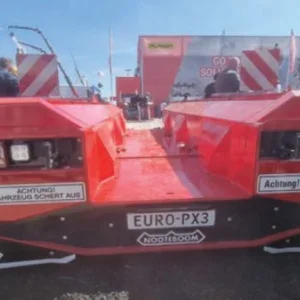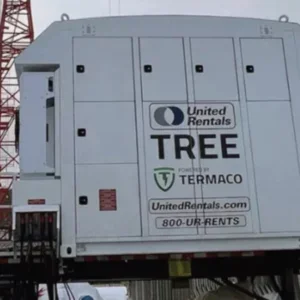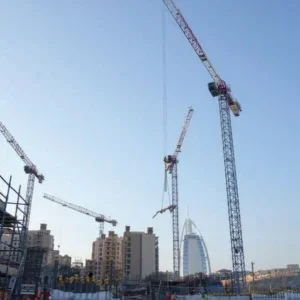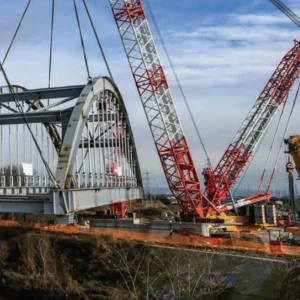Arguably the two biggest stories from Italian crane manufacturers this year are the takeover of Raimondi by its distributor SIME (see page XX) and Autogru Rigo winning its biggest ever order. As reported last month, Al Jaber Heavy Lift & Transport of Abu Dhabi placed a single order for 20 cranes with Rigo, comprised of 19 rough terrains ranging from 25t to 50 t capacity and one 100t capacity RTT 904 all terrain. The order was placed in January and the first shipment reached the customer on 12 March.
This quick delivery time is one of the key reasons for Rigo’s success. While most manufacturers are quoting lead times of anything up to a year currently, Rigo had six machines almost completed when Al Jaber’s plant manager, Keith Wood, visited in January. “They just needed a few options to be installed like lattice extensions, spark-arrestor stainless steel mufflers and air conditioning,” says Rigo’s export manager, Daniele Rigo.
Daniele Rigo says that for bigger companies a 20-crane order may sound nothing unusual, but for Rigo it is an unprecedented achievement.
Of course, availability was not the only criteria Rigo had to meet. Al Jaber’s order includes 14 units of Rigo’s new 50t RT, the RT 500/2. The lifting chart and 35m full power boom, compact dimensions, hydrostatic transmission and reasonable price all ticked the right boxes.
Another significant recent order was taken by Ormig, which has delivered an 80t truck crane, the 804AC, to the German rental company Franz Bracht. The order is significant because it shows that there truly is demand for the simpler truck mounted cranes in Germany. Not everyone wants an entire fleet of just all terrains.
The feedback back from the customer, says Ormig’s sales director Gian Paolo Aschero, is that with its 32t gross vehicle weight and compact size – 2.5m wide and 3.4m high – the crane is proving itself versatile in a wide range of applications because of its ready roadability. It is also being used with a trailer for the dis/assembly of lattice boom cranes.
Product development at Ormig continues to focus mostly on its pick and carry. New in 2005 was the battery powered 25tmE pick and carry crane, rated at 25t capacity.
“It offers remarkable performances with reduced overall dimensions (2.4m height),” says sales director Gian Paolo Aschero. “Furthermore, the fitting of a new generation electronic unit optimises the crane’s operability. The motor control is not depending on the remote switch any more and the hydraulic system pump is at variable delivery.”
Several attachments can be used with this crane, such as hydraulic and mechanical fly jibs or forks.
This year Ormig will introduce a new 16t capacity pick and carry crane, the 16tm, which has been designed as a strong lifter with an overall height reduced to just 2.4m.
SCM Srl has been developing its range of mobile cranes in recent years. The largest in its seven-model range, the 130t capacity all terrain model SCM 130T-TT, was introduced in 2004. Last year it restyled its 80t all terrain, the four-axle SCM 80T-TT, along the same lines, switching to more reliable and stronger Kessler axles and introducing Wabco ABS system for a better stability and safer emergency braking. The boom remains four sections with a maximum length of 42m and a maximum reach of 62m with jib.
“We are not a big company, but our philosophy to make strong and reliable machines, that are simple to use and safe for a long time, allow us to continue our work with good satisfaction,” says the company’s Gianluca Di Giosia.
Terex Bendini is building on the growing success of its telescopic boom crawler cranes with the introduction of two more new models this year, following last October’s launch of the TCC 45 at the SAIE show in Bologna. The TCC 45 lifts a maximum of 44t at 2.5m radius and has a five section boom that extends from 9.5m to 37.4m. Full production of this model begins next month.
The next two models following closely on are the TCC 40 and the TCC 60. The TCC 40 is basically a short boom version of the TCC 45, lifting 40t at 3m radius and having a 27.1m boom with the last section position mechanically.
The TCC 60 replaces the current A600C model, has a new Cummins engine, a new upper works and the cabin positioned on the left hand side cabin. The main general and lifting specifications remain the same as on the A600C.
September 2005 saw the start of distribution of two Bendini rough terrain crane models in the USA, in a bid to help out a market suffering from long delivery times as customer demand there is running faster than manufacturers’ ability to supply. The models available in the USA are the RT 440B (40 US ton capacity with 37.4m/123ft five-section full power boom) and the RT 660B (60 US tons, 32.4m/106ft four-section full power boom).
Upturning loaders
The loader crane segment is always hotly competed in Italy, with numerous manufacturers battling for market share. A common theme currently is the adoption of a feature first introduced by Palfinger a couple of years ago – the ability to bend the crane ‘backwards’ “backwards”, which in this context means actually upwards above the horizontal. This feature is designed to allow a load to be fed through an opening, such as a window, and then unloaded once the boom tip is raised.
Fassi is Italy’s largest producer of loader cranes, selling more than 7,000 units in 2005, with 80% of them exported. New from Fassi is the Evolution Series, the first models from which – the F240B and F260BXP – were shown at the last SAIE. The Evolution concept – which will cover all sizes up to the 45tm class – is to include all Fassi’s technological features, including double connecting rods, heat exchanger, remote control, Danfoss proportional distributor, and Fassi’s Prolink (progressive link) system for angling the boom 15° above the horizontal. Additionally, all the hoses supplying the stabiliser jacks are installed inside the stabiliser extension supports for protection.
Numerous other models will be given the Evolution treatment this year, including the F290A, F330D, F380B, F410B, F480B and F540B.
Following on from the launch of the continuous rotation F800 BXP at SAIE, Fassi will introduce two more continuous rotation models this year, the F385A and F415A with the same features. These include the Prolink system and Integral Machine Control that co-ordinates crane management and safety devices through a Canbus system connecting sensors.
The IMC pulls together the full function remote control as well as the Automatic Dynamic Control (ADC) feature. ADC is a device that controls the speed of the crane to maximise safety and minimise structural stress.
In the light series, Fassi will introduce the F135A and F155A this year. These will also have the double connecting rod mechanism and the Prolink function on the secondary arm to allows a working angle of up to 10° above the horizontal line.
Cormach is presenting its new 34000 E model at the Transpotec exhibition in Milano at the end of this month. This crane is designed along the lines of the 125000 E, with a split second boom. The traditional in-line booms are centred with the rotation centre. Rotation is achieved through a slew bearing activated by a rotation motor coupled with gear box and brake. The crane can be purchased with different boom lengths from the 10.01 m. of the 34000 E3 (three hydraulic extensions) up to the 21.11m. of the 34000 E8 (eight hydraulic extensions). A fly jib with four hydraulic extensions is also available. The 34000 E6F64 (six extensions on the crane and four on the jib) can reach a boom length of 26.85m. Maximum capacity is 7.4t with the 34000 E3 at 4m reach. The eight extensions model can lift 750kg at 21.11m. Cormach has also followed the trend here in having a boom that can be angled upwards. Both the main boom and the jib of the 34000 E can reach a 20 degrees negative angle. This model also has Danfoss proportional control valve and Hetronic radio remote control.
Autogru PM has also embraced the negative angle concept and has introduced 20° negative angle jibs, controlled by its PM Power Tronic electronic management system, on several models, including the 27S, 30SP, 44S, 48SP, 57S, 63SP, 72S and 80SP.
PM introduced three new models at SAIE: the 22 SP, the IDEA and the 3.5. The 22SP has been designed primarily for the building industry and is the first PM crane to have the ability to bend back above the horizontal on the main boom (between first and second section), in this case to a negative angle of 12 degrees. At 2.2m high and 2.5m wide and weighing 2690kg for the 6 extensions version, it can be installed on small trucks. The 22SP has the PM Power Tronic electronic management system, which normally PM puts only on cranes in the 27tm class and above. Other features include the increasingly common double connecting rods, hydraulic proportional control valve block, multifunction remote radio control and oil cooler integrated into the oil tank are. PM plans to offer this model in an LC version as well, with the hydraulic extensions retractable inside the first boom. It will also be available with a Rotzler winch.
Although the IDEA and the 3.5 are a similar size, in the 2.7tm class, they are quite different. The IDEA is available only in a one version with two extensions, lifting 250kg at maximum outreach of 7.1m. The 3.5 is available in three different versions, one of them with the LC system that improves the load capacity of the crane under the column. Various accessories are available for the 3.5, including radio remote control, a 460kg winch and manual boom extensions.
Since its change in ownership in 2002, when it was bought by investors led by current managing director Marco Milesi, PM has been striving for international growth as it works towards its goal of a stock market flotation to fund further growth and acquisitions.
Last year PM opened an office in Russia and took a stand at the CTT fair in Moscow. In the first few months, it sold 15 cranes there and is forecasting sales of 60 units in Russia in 2006. PM has also started in China, selling four cranes there, and has firm ambitions to have a direct presence in the market.
LB Speeder
Finally there is news of a famous name that has been rather quiet for a few years. LBS Spa began life in 1963 as a European manufacturing subsidiary of US manufacturer Link-Belt, when the latter was part of the FMC Corporation. Connections between the two companies ended several years ago and for many years LBS Spa has been mostly engaged in the production and distribution of spare parts for offshore cranes and Link-Belt and Speeder cranes in Europe, Africa and the Middle East.
This year, however, owner Andy Cosimo Burelli-Forti – several years past the age at which even the most enthusiastic workers normally retire – has closed his workshop in Milan.
Former employees Riccardo Carrai and Giorgio Uboldi have set up LB Speeder Srl to continue the parts service business. “For the immediate future LB Speeder’s activity is focused on the offshore platform market in addition to parts and service support of the large fleet of Link Belt cranes in Europe, Africa and Middle East countries,” Carrai says.
“Our warehouse has a stock of 8,000 parts which permits us to provide fast service (24 hours maximum) on the great majority of wear parts. All parts are manufactured or procured to exacting Link-Belt engineering specifications and are marketed under the original Link-Belt trademark,” says Carrai. However, his goal is to make enough of a success of the parts business to finance the manufacture of land-based cranes, just like the old days. “It is something we have in mind,” he says.






